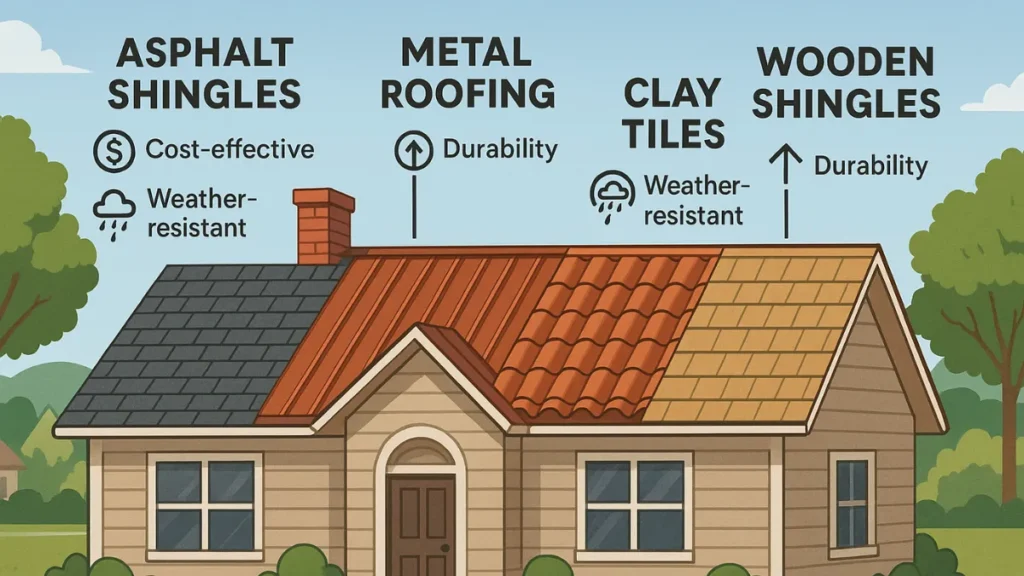Understanding Roof Ventilation
Roof ventilation is a crucial part of your home’s entire HVAC system, designed to help control temperature, reduce moisture, and improve air circulation in your attic and house. Good ventilation lets fresh air flow through the attic, therefore avoiding the accumulation of heat and moisture.
This keeps the inside temperature more constant, which increases comfort within your house independent of the season. In the summer, your attic may become a heat trap without enough ventilation; in the winter, too much moisture might cause mold development, wood rot, and insulation damage.
Basically, roof ventilation is rather important for maintaining the structural integrity of your house and improving its whole energy efficiency. Installable proper ventilation systems may be made from exhaust vents—which let warm, damp air escape—and intake vents—which let fresh air enter.
These vents cooperate to produce a constant airflow when they are operating as they should, therefore lowering the risk of heat or moisture accumulation. Installing roof ventilation helps homeowners safeguard their property from any harm and raise their degree of comfort.
The Impact on Energy Efficiency
One of the main advantages of appropriate roof ventilation is how much better energy efficiency results. Heat accumulating in the attic during the summer months can raise the home’s indoor temperature. This trapped heat might compel your air conditioning system to run more aggressively without enough airflow, increasing your energy costs.
By letting hot air exit the attic and hence lower the home’s total temperature, roof ventilation helps to solve this issue. This will help your HVAC system be less strained, and energy expenses will be lowered if your air conditioning unit runs less often or for less duration.
Inadequate ventilation in winter can also result in heat loss, as trapped moisture in the attic could build ice dams on the roof. Warm air from the house melts snow on the roof, creating these ice dams wherein the water refreezes near the edge of the roof from lower temperatures.
This can seriously compromise gutters as well as the roof. Good attic ventilation allows steady airflow that keeps the attic temperature more constant, therefore lowering the possibility of ice dams developing. This therefore helps keep your house warm, thereby reducing needless heat loss and increasing your energy efficiency.
Enhancing Indoor Comfort
By helping to control inside temperatures all year long, roof ventilation greatly increases the comfort level of your house. An attic without enough ventilation can rapidly turn into a sauna-like condition with temperatures reaching 140°F in hot summer months.
This excess heat then moves into your living areas, giving the house a warmer feel than it should have. Conversely, a well-ventilated attic lets hot air leave, therefore maintaining a more constant and pleasant inside temperature.
Winter brings another factor influencing comfort: moisture accumulation. Inadequate ventilation allows moisture from cooking, bathing, and even breathing to gather in the attic. This moisture can provide a perfect habitat for mildew and mold development, therefore compromising the general comfort and air quality.
Ensuring enough roof ventilation helps you to lower the possibility of extra moisture building up and guarantee that the indoor air quality stays fresh and clean. Year-round, regardless of the outside temperature, your house will feel more pleasant with regular circulation throughout your attic and living areas.
Prolonging the Lifespan of Your Roof and Home
Prolonging the lifespan of your roof and home ventilation is vital not only for comfort and efficiency but also for the longevity of your house’s construction. Too high heat levels could cause early deterioration of roofing materials in the attic.
Particularly asphalt shingles might suffer from heat damage, which would lead to cracking, warping, and loss of protective granules. Your roof’s lifetime may be greatly decreased without enough ventilation, which would result in expensive repairs or replacement much ahead of the required timescale.
Furthermore, the moisture accumulation resulting from inadequate ventilation could cause trusses and rafters to decay, therefore compromising the structural integrity of your house. Furthermore, mold and mildew development can lead to health issues for the residents of the dwelling.
Keeping proper roof ventilation guarantees that the attic remains dry, cool, and well-ventilated, which extends the lifespan of the roof and other structural components of your home. By means of consistent maintenance of your roof ventilation system, you may help avoid these problems and maintain the safety, security, and good condition of your house for many years to come.
FAQs
1. How do I know if my roof has proper ventilation?
Signs of poor roof ventilation include excessive heat in the attic, moisture buildup, ice dams in winter, or high energy bills. If you notice these issues, you may need to evaluate your ventilation system.
2. Can roof ventilation help with energy costs in winter?
Yes, roof ventilation helps maintain consistent attic temperatures, preventing heat loss and reducing the likelihood of ice dams, which can make your home more energy-efficient during winter months.
3. Is roof ventilation difficult to install?
Roof ventilation installation can be complex and should be done by a professional roofer. Depending on your home’s structure, it may involve adding vents, sealing gaps, or installing an exhaust system.
4. How often should roof ventilation be inspected?
It’s a good idea to have your roof ventilation system inspected annually to ensure it’s functioning correctly. You should also check it after severe storms to ensure no vents or components were damaged.
Conclusion
From enhancing internal comfort to boosting energy efficiency and extending the lifetime of your roof, including appropriate roof ventilation in the design of your house will provide several advantages. Roof ventilation helps to control temperatures, lower moisture buildup, and stop damage resulting from heat or ice by letting air flow freely in your attic.
A well-ventilated attic may also help your HVAC system run less strained, which will save energy expenses and provide a more comfortable living space. Professional installation of your roof ventilation system and regular maintenance can provide maximum advantages, therefore safeguarding your house and improving its general efficiency.


